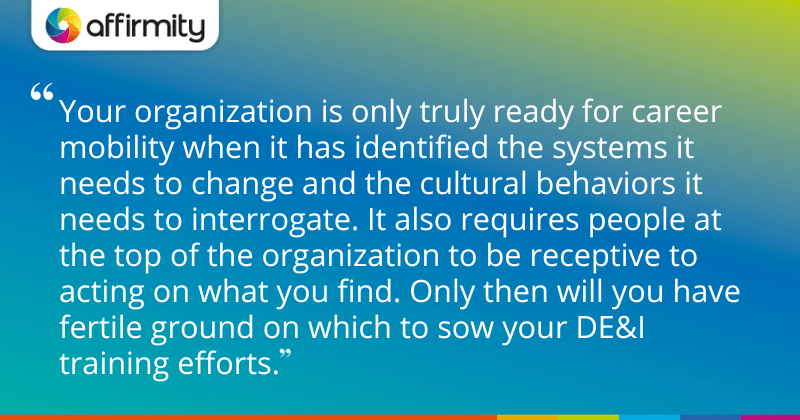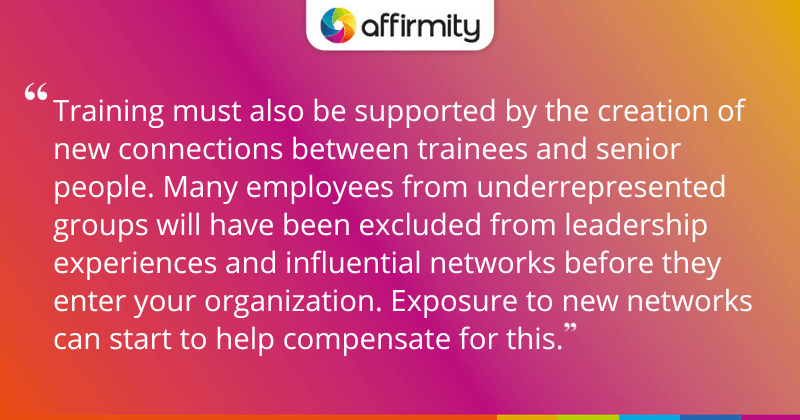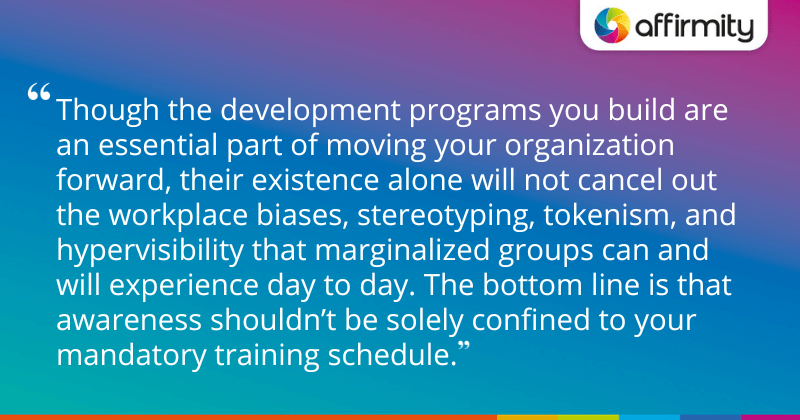Slow progress on diversity, equity, and inclusion isn’t always a matter of organizations devoting little effort towards their programs—but many businesses need to work smarter rather than harder to effect real change in crucial areas. In this article, Nic Girvan, Global Director of Learning and Delivery at GP Strategies (an Affirmity inclusion training partner), examines the importance of career mobility in addressing DE&I across the business.
McKinsey’s oft-cited claim that ethnically diverse senior teams are 36% more likely to be strong financial performers (and more gender-diverse senior teams 25% more likely for the same) may be a compelling one. However, several years after that claim was made, it and a history of similar arguments haven’t yet resulted in a drastic change in representation.
Though changes at the top naturally take time, organizations must ensure the diverse leadership pipelines they build are fit for purpose. Here are five questions organizations should be asking if they’re to ensure the career mobility of marginalized groups:

1. Is Your Organization Ready for Career Mobility?
Addressing career mobility isn’t about correcting your talent in some way—it’s actually far more about your organization taking a long hard look at its systems, as well as its environment and culture, and interrogating whether these elements actually support employee progression. For this reason, an organization must be introspective and work to uncover the barriers that exist in the workplace before it embarks on the design of leadership development programs. Or, in fact, before it embarks on training programs of any kind.
Challenging your own organizational readiness may involve, for example, examining whether the criteria for advancement are subject to biases and assumptions that have gone overlooked. Organizations may also have legacy attitudes about the kind of individual who works best in a senior position. Perhaps the organization’s very idea of who is “talented” is too narrow, or existing career mobility processes are too homogeneously designed to account for, support, and benefit from the full range of brilliant employees available.
Useful lines of inquiry include:
- Compare your promotion statistics with your diverse representation. Are there any significant patterns? What could be the root cause of these disparities?
- Does everyone in your organization understand your existing processes, and is information about them readily available?
- Are your performance management systems fair and equitable, and are managers trained to deploy them properly?
- Does your organizational culture value certain work styles—and are there implications in these value judgments that disadvantage specific groups?
Your organization is only truly ready for career mobility when it has identified the systems it needs to change and the cultural behaviors it needs to interrogate. It also requires people at the top of the organization to be receptive to acting on what you find. Only then will you have fertile ground on which to sow your DE&I training efforts.
YOU MAY ALSO ENJOY READING | ‘5 Ways Organizations Can Reduce the Impact of the Imposter Phenomenon’

2. Are Your Leadership Training Programs Fit for Purpose?
Your typical off-the-shelf leadership training program is unlikely to be fit for purpose without significant modification. You’ll need to seek input from diverse voices to understand the barriers to career advancement in your context, and to work to incorporate those insights into what you offer. Properly targeted programs will deconstruct the barricades that politics and power present, while emphasizing how identity influences and strengthens leadership styles.
You may also want to think beyond your usual training team—a group of facilitators with significant experience and/or knowledge of leadership topics from a range of perspectives will bring your program alive with insight and authenticity.
LEARN ABOUT LEADERSHIP’S ROLE | ‘The Undeniable Value of Inclusive Leadership and Visible Equity’
3. Have You Engaged Your Front-Line Managers?
Training must be followed by accountability. This means that the organization should validate that front-line managers are nurturing and supporting their team members. Development programs aren’t complete if staff don’t have a career plan in place. Organizations must ensure that L&D teams engage with managers during any training rollout. Hold a kick-off event, create resources for managers to work through with participants, and impress upon them their obligation to create opportunities for team members.

4. Are Your Sponsor and Mentor Opportunities Aligned to Formal Development?
Training must also be supported by the creation of new connections between trainees and senior people. Many employees from underrepresented groups will have been excluded from leadership experiences and influential networks before they enter your organization. Exposure to new networks can start to help compensate for this.
Your leadership development efforts should be supported by sponsorship and mentorship programs. Introduce your underrepresented trainees to influential sponsors who can create opportunities within the organization. Meanwhile, you will need experiential mentors who are trained to act as effective allies—these individuals will be able to bring their lived experience to any discussion of career pathing, helping trainees understand some lesser-discussed aspects of what is required.
READ MORE ON MENTORSHIP’S ROLE | ‘3 Ways to Use Inclusion to Create a Better, More Diverse Work Environment’
5. Is Your Organization Inclusive Enough for This to Work?
Though the development programs you build are an essential part of moving your organization forward, their existence alone will not cancel out the workplace biases, stereotyping, tokenism, and hypervisibility that marginalized groups can and will experience day to day. DE&I efforts must be an undercurrent running through every aspect of your organization’s operations if inclusion is to be improved and systemic discrimination is to be removed entirely.
For example:
- Recruiters should be trained to integrate inclusive hiring behaviors into their process
- Panel events should encourage speakers from diverse backgrounds
- Diversity metrics should be overlaid on the insights from staff surveys in order to highlight issues common to certain groups
- Casual training schedules (such as your “lunch-and-learn” series) should cover topics such as power and privilege, psychological safety, and cultural curiosity
The bottom line is that awareness shouldn’t be solely confined to your mandatory training schedule—if inclusion is ever to be normalized as something employees actively consider, it needs to have in a place in everything that makes the organization tick.
If you would like to discuss how to become a more diverse, inclusive, and equitable organization, please contact us today.
A version of this article originally appeared on Training Industry.
 About the Author
About the Author
Nic Girvan is the Global Director of Learning and Delivery at GP Strategies. She’s an expert in business psychology, adult learning practice, modern leadership, and DE&I transformation. In her role, she emphasizes that it’s only possible for organizational development strategies to result in measurable change when innovative and enhanced methods of delivery are fully embraced.
